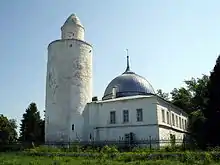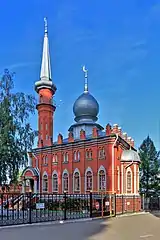Orenburg Caravanserai
The Orenburg Caravanserai (Bashkir: Каруанһарай) is Mosque, historical and architectural complex in Orenburg, cultural monuments of the Bashkir people.[1]
| Orenburg Caravanserai | |
|---|---|
_01.jpg.webp) | |
| Location | 6 Park Avenue, Orenburg Orenburg Oblast,460000 |
| Built | 1837-1844 |
| Architect | Alexander Brullov |
| Architectural style(s) | Islamic architecture |
| Governing body | The Orenburg Oblast Government |
The building is located at 6 Park Avenue, Orenburg.
Was built in 1837 – 1846 years on voluntary donations to place the Office of Bashkir-mesheryak army commander, hotels for Bashkirs who came to Orenburg "in their need for services and" workshop and school for the Bashkirs. Historical and architectural complex consists of Bashkir folk houses and mosques. The original design of the architect Alexander Brullov was designed as a pastiche of traditional Bashkir village: central dominant ensemble - octagonal mosque reproduced form Bashkir yurt.
The building housed the Orenburg Bashkir Pedagogical College (1920-1924).
Construction and opening
History of Orenburg Caravanserai begins decades before the start of its construction. Bashkirs have repeatedly appealed to the tsarist authorities for permission to build in Orenburg - then the administrative center of the Bashkir land - the building where their children could acquire knowledge, learn crafts. At the insistence of the people of the canton chiefs gathering on his foreman instructed Canton Kagarmanov Kuvatova achieve the highest in St. Petersburg building permits in Orenburg Bashkir Caravanserai. After several years of ordeal Kuvatov received such permission from the Emperor Nicholas I.
With the active participation of the Bashkirs were implemented collection of fixed assets and construction of the complex. Production of building materials, transportation and all other construction activities also performed Bashkirs. In some periods in the works involving more than one thousand Bashkirs with horses. The magazine "Russian Antiquity" in 1896 said that all the buildings were made Bashkirs appointed regiment and cantons: "Required for buildings wood floated down the river from Bashkiria SAKMAR Bashkirs same. Lime stone and also produces them in 20 miles from Orenburg to Grebenskaya mountain. "
Caravanserai on all sides was surrounded by a park, an area of more than 5 hectares. Creation of the park was conceived in conjunction with the design and construction of buildings and carried out in the early 1850s. All planting material for the park has been taken out of the woods Sterlitamaksky County and other places of Bashkortostan. Perennial trees in huge tubs delivered to Orenburg for a hundred kilometers or more.
Completion of the main body Caravanserai relates to 1842. Some of the rooms of the upper floor were completed earlier, and in December 1841 they had already placed Chancellery of Bashkir-mesheryak army commander. Construction of the mosque and the minaret was completed in 1842 (according to other sources - in 1844) year. Took a long time interior of the mosque and minaret exterior cladding tiles.
Total construction cost Caravanserai (in February 1845) was 84,295 rubles. silver or 295,034 rubles. banknotes. Construction was allocated mainly of Bashkir public treasury - 71,564 rubles. silver (250,474 rubles. banknotes). More than 30,000 rubles of banknotes were collected by Bashkir villages.
Celebrations to mark the opening of the Caravanserai were timed to the birthday of Nicholas I of Russia and took place August 30, 1846. The celebrations gathered from all corners of the Bashkirs of Bashkortostan. Was arranged grand celebration organized refreshments, held traditional Bashkir horse racing. Held a public service in the mosque (the first mullah - Gataulla Altynguzin, attended by about 3.5 thousand parishioners).
References
- "Башкортостан. Краткая энциклопедия:Карава́н-сара́й (Каруанhарай)" (in Russian). Archived from the original on January 13, 2013. Retrieved June 5, 2014.

.jpg.webp)




